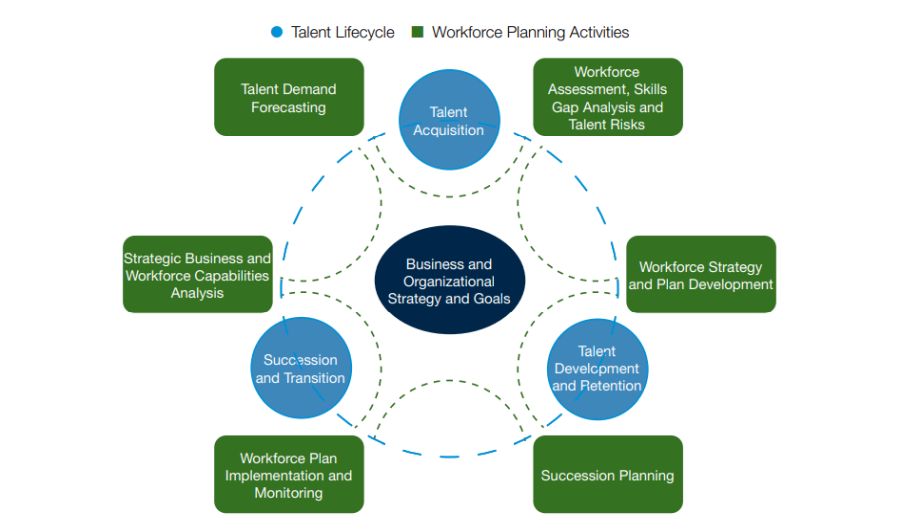- within Law Practice Management topic(s)
- in United States
- within Insolvency/Bankruptcy/Re-Structuring and Law Department Performance topic(s)
The $8.5 trillion talent gap isn't just a recruitment problem; it's an existential business risk that needs a comprehensive strategy.1
In the rolling hills of North Dakota's Bakken oil formation, energy companies face a perpetual challenge that threatens their very existence — finding and keeping skilled professionals willing to work in remote locations while maintaining the specialized expertise required by increasingly stringent regulations. It's not just an HR headache; it's a strategic risk that directly impacts operational continuity, safety compliance and bottom-line results.
This scenario isn't unique to the energy industry. From rural healthcare systems to remote manufacturing facilities, specialized industries are recognizing that siloed talent approaches no longer work in a landscape where workforce planning, risk management and business strategy must operate as a unified system.
"We've moved beyond treating talent as merely an HR function," explains Dr. Caroline Walsh, an organizational resilience expert at Cornell University. "Forward-thinking organizations now view their workforce planning as fundamentally integrated with risk management and business continuity. The companies thriving in remote specialized sectors are those that have made this connection explicit."2
Talent risk has moved from focusing on roles to identifying critical capabilities, the technical expertise, industry knowledge, operational knowhow and leadership skills that drive competitive advantage.

The Interconnected Talent Ecosystem
Talent is a dynamic, interconnected system of risk, succession, development and acquisition.
Traditional workforce planning focused primarily on headcount forecasting and filling organizational charts. Today's integrated approach recognizes talent as a complex, adaptive system where risk, succession, development and acquisition are dynamically interconnected.
When a critical subject matter expert (SME) in a regulated or specialized industry leaves without knowledge transfer, it creates a cascade of consequences: Compliance risks increase, quality may suffer, innovation stalls, and recruitment costs skyrocket to replace specialized expertise. Understanding these connections transforms reactive talent management into strategic risk mitigation.
The most advanced organizations are building dynamic talent risk matrices that quantify impacts across the business when specific capabilities are compromised. Each position is scored not just on replacement difficulty, but on organizational vulnerability if left unfilled, creating a heat map of talent priorities that directly informs succession plans, development investments and recruitment strategies.
In assessing talent risk, every position is scored not just on replacement difficulty, but on organizational vulnerability if left unfilled.
From Critical Roles to Critical Capabilities
A paradigm shift is underway in how organizations define talent risk, particularly in specialized industries. This evolution has moved from focusing on critical roles to identifying critical capabilities, the distinctive, sometimes rare combinations of technical expertise, industry knowledge, operational know-how and leadership skills that drive competitive advantage.
According to Jeff Cass, a Managing Director with Alvarez & Marsal (A&M), "Succession planning and leadership development efforts should start with a relevant 'Success Profile.' Designing that success profile should be oriented toward the future, including upcoming business imperatives and capabilities needed in the future."
This capability-centric approach transforms how organizations approach succession planning, development and recruiting:
- Succession becomes about capability coverage, not individual replacement, ensuring critical knowledge is distributed among multiple team members rather than concentrated with a single person.
- Development initiatives target capability gaps in specific technical and leadership competencies that represent the highest vulnerability based on talent risk assessments.
- Recruitment strategies expand beyond direct replacements to search for talent with adjacent skills who can be developed into specialized roles, rather than limiting searches to candidates with identical backgrounds.
Predictive Analytics: The New Frontier in Talent Risk Management
Adam Malamut, a colleague of Cass at A&M, shared that: "Advanced organizations are now applying predictive analytics to anticipate talent vulnerabilities before they materialize. These systems integrate data across multiple dimensions, including retirement eligibility, historical turnover patterns, market compensation trends, and even social factors like spousal employment opportunities in remote locations, to identify where talent risks are likely to emerge."
Predictive models combine data on retirement eligibility, turnover patterns, market compensation, and social factors like spousal employment to pinpoint potential talent risks.
The most effective predictive talent models incorporate multiple data streams, including:
- Internal workforce data – demographics, skills inventories, performance metrics and career progression patterns.
- Market intelligence – compensation trends, competitor movements and industry-specific labor market dynamics.
- Operational insights – current and historical talent gaps and talent-related impacts on business performanec metrics.
- Geographic factors – community development, housing availability and lifestyle amenities that influence talent attraction and retention in remote locations.
These predictive capabilities transform workforce planning from a reactive process into a proactive strategic function that directly supports business continuity and risk management.
The Integration Imperative: Breaking Down Talent Silos
Organizations leading in specialized remote talent management have one thing in common; they've dismantled the traditional barriers between talent acquisition, development, succession planning and risk management. This integration manifests in several tangible ways:
- Cross-functional talent councils bring together operations, finance, risk management and HR to collectively own workforce planning and talent risk mitigation.
- Unified talent technology ecosystems integrate skills databases, learning management, succession planning and recruitment into cohesive platforms providing comprehensive talent visibility
- Capability-based organizational design defines roles around essential capabilities rather than traditional job descriptions, creating natural pathways for knowledge transfer and career development.
- Agile talent pools replace rigid succession charts with flexible talent communities prepared to step into multiple roles as organizational needs evolve.
Remote Location Strategies: Turning Geographic Challenges Into Talent Advantages
Erin Gore, a Managing Director at A&M, shares that for clients she is working with in remote locations, "The integration of talent strategies and a novel employee deal that appeals to a whole family unit becomes even more critical." Leading companies are transforming potential disadvantages into strategic differentiation through several approaches:
- Accelerated advancement opportunities appear explicitly in employer branding, highlighting how faster skill development and leadership progression can offset geographic challenges.
- Capability incubators partner with local educational institutions to develop specialized talent pipelines aligned with organizational needs.
- Technology-enabled flexibility creates hybrid roles that balance on-site operational requirements with remote work options where regulatory and operational constraints allow.
- Community investment develops the amenities, housing options and quality of life factors that make remote locations more attractive to specialized talent.
The Future of Integrated Talent Management
The organizations that will thrive in specialized industries and remote locations are those building comprehensive talent ecosystems where risk management, succession planning, development and acquisition operate as a unified strategy rather than disconnected functions.
The path forward requires several shifts in perspective:
- Moving from reactive to predictive talent risk management
- Evolving from role-based to capability-based workforce planning
- Transitioning from siloed talent functions to integrated talent ecosystems
- Transforming geographic challenges into strategic talent advantages
As the competition for specialized talent intensifies, this integrated approach to managing business isn't just a best practice. It's becoming an imperative for organizational resilience and sustainability
A Tactical Start to Identifying Talent Risk
1. Rapid Capability Map
- What: Create a simple three-column spreadsheet listing Critical Capability | Current Holders | Risk Score (1–5).
- Who: Have department heads identify their top three "can't lose" specialized skills.
- Immediate Action: For any capability with fewer than two holders, schedule a 30-minute weekly knowledge transfer session.
2. Assess Your Risk
- Identify: For each department identify single most vulnerable position.
- Impact: For each position, document specific operational impacts if a vulnerable position is vacant (production delays, compliance issues, etc.).
- Triage: Create simple backup plans with specific names and development needs.
- Risk Adjust: Identify which people are the backups for multiple positions and create a secondary risk.
3. Build Your Plan
- Document: Create "technical one-pagers" for specialized processes (one-page maximum).
- Shadow: Implement "ride-along" shadowing for critical roles for immediate backfills.
- Technology: Use smartphone video to record expert demonstrations of specialized tasks.
- Quick Win: Start with documenting the top five "only one person knows how" procedures.
4. Develop Your Remote Location Talent Strategy
- Financial Impact: Document the financial cost of the missing skills and roles; adjust for your business model margins.
- Recruiting Tool: Create a "total value calculator" comparing cost-of-living adjusted compensation to urban alternatives.
- Market Scan: Research and map available talent pools in target remote locations, including skill availability, compensation benchmarks, local educational institutions, and competitor presence to identify optimal geographic markets for recruitment.
- Immediate Benefit: Implement or review housing allowances or company-provided housing and family benefits with clear dollar value.
- Community Building: Create monthly "family days" with structured activities for employee families.
This approach emphasizes immediate, low-cost implementation steps that can be started within days rather than months, with clear owners and tangible outcomes.
Originally published 24 June, 2025
The content of this article is intended to provide a general guide to the subject matter. Specialist advice should be sought about your specific circumstances.





